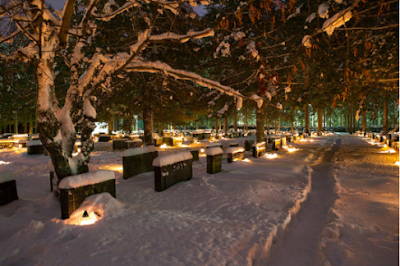Friday, December 21, 2018
Happy Holidays From The ARBICO Family!
Tuesday, December 18, 2018
Let’s Go Abroad For Christmas

Let’s begin with Japan: The Japanese have long embraced the quirky way of doing things and their Christmas celebrations are no different. I think it’s safe to say you won’t find a Godzilla Christmas tree anywhere else. Christmas is a bit like Valentine’s Day in this non-Christian country; presents are given between lovers and going out for romantic dinners is the thing to do. The “it” place to dine -Kentucky Fried Chicken (it’s a long story, but suffice to say a 70’s marketing scheme worked better than anyone could have imagined – more on that here).
Workers in Bolivia and Brazil get extra pay in December. In Bolivia, it’s known as El Aguinaldo (The Bonus) and is mandated by law.
These countries have large
 populations of underpaid and underrepresented workers, so this money must be tremendously appreciated at Christmastime. In Rio de Janeiro, Santa braves the favelas each year to make sure no child there is missed.
populations of underpaid and underrepresented workers, so this money must be tremendously appreciated at Christmastime. In Rio de Janeiro, Santa braves the favelas each year to make sure no child there is missed.
In Sweden, Yule goats (small goats made from straw) are a traditional decoration. Back in 1966, the town of Gävle decided to create something spectacular to draw people to their downtown. So they built a straw goat that is over 42 feet tall and 26 feet long. The original Gävle Goat was burned down on New Year’s Eve of that year, but was re-built the next year. Every year since, someone has tried to burn the poor thing down. In 52 years, the goat has been burned down 36 times, a clear win for the burners. These days, the goat can be monitored by webcam, but that didn’t prevent it from being torched in 2016, it just made for a nice clear video of it burning. Let’s see who wins this year.
 populations of underpaid and underrepresented workers, so this money must be tremendously appreciated at Christmastime. In Rio de Janeiro, Santa braves the favelas each year to make sure no child there is missed.
populations of underpaid and underrepresented workers, so this money must be tremendously appreciated at Christmastime. In Rio de Janeiro, Santa braves the favelas each year to make sure no child there is missed.In Sweden, Yule goats (small goats made from straw) are a traditional decoration. Back in 1966, the town of Gävle decided to create something spectacular to draw people to their downtown. So they built a straw goat that is over 42 feet tall and 26 feet long. The original Gävle Goat was burned down on New Year’s Eve of that year, but was re-built the next year. Every year since, someone has tried to burn the poor thing down. In 52 years, the goat has been burned down 36 times, a clear win for the burners. These days, the goat can be monitored by webcam, but that didn’t prevent it from being torched in 2016, it just made for a nice clear video of it burning. Let’s see who wins this year.

 Guatemala has its own burning tradition in December, La Quema del Diablo (The Burning of the Devil). On December 7, people gather to burn effigies of the Devil and party around the bonfires. It is an old tradition that is found in other Latin American countries and is seen as a way to clean out the bad/evil from the previous year in anticipation of starting out fresh in the New Year.
Guatemala has its own burning tradition in December, La Quema del Diablo (The Burning of the Devil). On December 7, people gather to burn effigies of the Devil and party around the bonfires. It is an old tradition that is found in other Latin American countries and is seen as a way to clean out the bad/evil from the previous year in anticipation of starting out fresh in the New Year. Further south in Venezuela (Caracas, to be exact), they have developed an interesting way to get to church on Christmas – they roller-skate. The origins of this custom may be somewhat murky, but nowadays it is firmly a part of Christmas in Caracas. The government even closes streets down early Christmas morning so large groups of people can skate safely to mass. This light-heartedness extends to the rest of their day as people gather in the streets to eat, dance and party in general.
Further south in Venezuela (Caracas, to be exact), they have developed an interesting way to get to church on Christmas – they roller-skate. The origins of this custom may be somewhat murky, but nowadays it is firmly a part of Christmas in Caracas. The government even closes streets down early Christmas morning so large groups of people can skate safely to mass. This light-heartedness extends to the rest of their day as people gather in the streets to eat, dance and party in general. And now for something less reverent: people in Catalonia may not have the same Nativity scene most people are familiar with. In this part of Spain they have something a little extra tucked away in a corner–El Caganer (The Crapper). There you will see a figure relieving himself. Although this is another custom with unclear roots, it is commonly seen to be a symbol of good luck. In the past El Caganer figures were male and dressed in traditional Catalan clothing, but these little figures have been swallowed up into the pop culture universe and are available as politicians, celebrities and many other things. See here for more statues pooping than you could have ever dreamed existed. Apparently small El Caganer figures are not enough, in 2010 a mall in Barcelona sported a 19 foot tall figure. Hopefully it was far away from the food court.
And now for something less reverent: people in Catalonia may not have the same Nativity scene most people are familiar with. In this part of Spain they have something a little extra tucked away in a corner–El Caganer (The Crapper). There you will see a figure relieving himself. Although this is another custom with unclear roots, it is commonly seen to be a symbol of good luck. In the past El Caganer figures were male and dressed in traditional Catalan clothing, but these little figures have been swallowed up into the pop culture universe and are available as politicians, celebrities and many other things. See here for more statues pooping than you could have ever dreamed existed. Apparently small El Caganer figures are not enough, in 2010 a mall in Barcelona sported a 19 foot tall figure. Hopefully it was far away from the food court. People in New Zealand don’t have any customs quite as extraordinary as a scatological statue, but they have a special Christmas tree, the Pōhutukawa (Metrosideros excels). Known as the New Zealand Christmas tree, this large and beautiful tree blooms with vivid red flowers in December and January (summer in that part of the world). It is a staple in Kiwi Christmas cards and decorations and has deep meaning to the native Maori. Sitting under one of these on a warm Christmas Day does sound inviting. On another note, it seems that Santa Claus may not get milk and cookies from Kiwi kids, beer and pineapple chunks are often on the menu instead. I’ll bet he goes there last.
People in New Zealand don’t have any customs quite as extraordinary as a scatological statue, but they have a special Christmas tree, the Pōhutukawa (Metrosideros excels). Known as the New Zealand Christmas tree, this large and beautiful tree blooms with vivid red flowers in December and January (summer in that part of the world). It is a staple in Kiwi Christmas cards and decorations and has deep meaning to the native Maori. Sitting under one of these on a warm Christmas Day does sound inviting. On another note, it seems that Santa Claus may not get milk and cookies from Kiwi kids, beer and pineapple chunks are often on the menu instead. I’ll bet he goes there last.So, pick your favorite custom and let’s go abroad for Christmas!
Submitted by Pam
Tuesday, December 11, 2018
Turn Christmas On Its Head
My blog from last week on colored Christmas trees got me going on unusual things that can be done with yuletide designs, trees in particular. Which led
me immediately to the
 |
| Claridge's, London 2017 |
 upside-down tree. This trend has reared its controversial head in our country in recent years, but it has been around for a while in Europe. It dates back to sometime in the Middle Ages, although exact dates are up for debate. At that time, its shape was seen as a way to represent Christ’s cross or the Holy Trinity. Interestingly enough, many people today believe that the pointy end of the tree points to Heaven, thus making this the proper placement for religious significance.
upside-down tree. This trend has reared its controversial head in our country in recent years, but it has been around for a while in Europe. It dates back to sometime in the Middle Ages, although exact dates are up for debate. At that time, its shape was seen as a way to represent Christ’s cross or the Holy Trinity. Interestingly enough, many people today believe that the pointy end of the tree points to Heaven, thus making this the proper placement for religious significance.The upside-down display became popular in retail settings in the 19th century. It was seen as a great way to present ornaments at eye level and to free up floor space. Upside down trees are especially popular in hotels and retail spaces today for these same reasons.
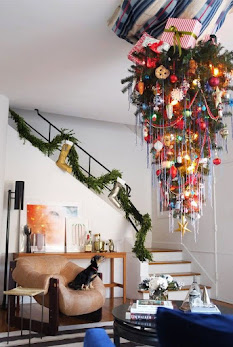
Besides commercial properties, who is this for?
- Fans of Stranger Things on Netflix who are already comfortable with the Upside Down- Apartment and other small-space dwellers
 - Parents with small children who want to keep those little hands off the tree (you could even place a platform above the tree to put presents on)
- Parents with small children who want to keep those little hands off the tree (you could even place a platform above the tree to put presents on) |
| Wall tree |
- People with mischeivious and/or naughty little pets
- Someone who wants to get their friends and family talking
 Not quite ready to commit to a full-on upside-down tree? Here are some options:
Not quite ready to commit to a full-on upside-down tree? Here are some options: - Hang a small artificial tree over a table for a centerpiece that leaves plenty of room for the food on the table.
- Hang a small artificial tree over a table for a centerpiece that leaves plenty of room for the food on the table.- Cut a small tree in half, hang the pointy end and create a Christmas chandelier. Use the remaining branches as garland around the room.
- Cut the very tip off a tree (or fashion one with wire and branches ) and hang it on a wall.
- Create an abstract tree from whatever strikes your fancy.
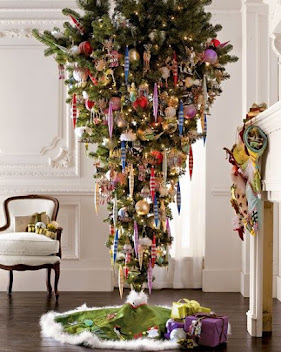
 |
| Upside-down presents! |
Unless you are working with an upside-down tree that sits on the floor, when decorating your tree the weight of your decorations should be carefully considered. Think ribbons, twinkly fairy lights, lightweight plastic and lots of tinsel.
Go big, go small, hang them from the ceiling, hang them on a wall – you are only limited by your creativity when it comes to upside-down Christmas trees.
Submitted by Pam
Monday, December 10, 2018
The Curious Christmas Tale of Amanita Muscaria
Santa and his reindeer have, over the years, become the ubiquitous symbol of western Christmas celebration. Despite the overarching religious narrative around Santa Claus and St. Nicholas, there are some that have called the true origin of a sleigh-driving man led by flying reindeer into question. Anthropologists and mycologists have traced a historical link back to mind-altering fungi.
The Gifts of Winter
This new origin theory suggests that the figure of Santa arose from the practices of shamans native to Siberian and Arctic areas. They would arrive in settlements around the Winter Solstice with a bag stocked full of “presents.” These presents came in the form of Amanita muscaria – a hallucinogenic mushroom more commonly known as the fly agaric or “holy mushroom.” The native people often lived in teepee-esque houses with a single opening to the ground. Since snow often blocked that entrance, the shamans would drop their tidings through an opening in the roof, hence the story of Santa coming through the chimney.
The Botanical Link
That is not the only link these entheogens (substances that induce a spiritual experience) have to our modern festivities. Have you ever wondered why placing presents under a tree came to be the norm or why pine trees are the preferred “Christmas tree”? Well, fly agaric mushrooms are commonly found lurking at the base of conifer and birch trees with their bright red coloration and white spots calling attention to them. From the native’s perspective, the trees were the resting place for their gifts – an important spiritual element of their lives. Moreover, their colors have been adopted for wrapping paper, seasonal decorations and Santa himself.
But Why The Flying Reindeer???
This is where it gets a bit more involved with the “experience.” Unfortunately, reindeer cannot fly, but our minds are palaces of imagination and wonder. The symbol of a flying sleigh led by reindeer embodies the taking of a “trip” and traveling to a different plane of consciousness. The vessel was more symbolic than practical and as Carl Ruck put it, “Amongst the Siberian shamans, you have an animal spirit you can journey with in your vision quest and reindeer are common and familiar to people in Eastern Siberia.” With the Amanita muscaria induced departure from reality, the people connected elements of their environment to their psychedelic experiences. These connections helped build spiritual importance of the animals to the people who lived with them. As other groups of people intermingled in time, stories were shared and mythos was merged.
As traditions and groups of people congealed, elements of
the past remained. Reds and whites dominate the Christmas season, Santa still
drops in through the chimney, conifers are sold as Christmas trees (even multi-colored), and airborne reindeer still dot the gift cards, decorations and
movies of the season. No matter how far we come, traces of what came before can
still be found. The Christmas that we know is just one example of that. So
remember…instead of cookies, pick some mushrooms and leave those for your
Christmas Eve visitor this year.
 |
| Fly Agaric, Amanita muscaria |
This new origin theory suggests that the figure of Santa arose from the practices of shamans native to Siberian and Arctic areas. They would arrive in settlements around the Winter Solstice with a bag stocked full of “presents.” These presents came in the form of Amanita muscaria – a hallucinogenic mushroom more commonly known as the fly agaric or “holy mushroom.” The native people often lived in teepee-esque houses with a single opening to the ground. Since snow often blocked that entrance, the shamans would drop their tidings through an opening in the roof, hence the story of Santa coming through the chimney.
 |
| A Little Mushroom Forest |
That is not the only link these entheogens (substances that induce a spiritual experience) have to our modern festivities. Have you ever wondered why placing presents under a tree came to be the norm or why pine trees are the preferred “Christmas tree”? Well, fly agaric mushrooms are commonly found lurking at the base of conifer and birch trees with their bright red coloration and white spots calling attention to them. From the native’s perspective, the trees were the resting place for their gifts – an important spiritual element of their lives. Moreover, their colors have been adopted for wrapping paper, seasonal decorations and Santa himself.
But Why The Flying Reindeer???
This is where it gets a bit more involved with the “experience.” Unfortunately, reindeer cannot fly, but our minds are palaces of imagination and wonder. The symbol of a flying sleigh led by reindeer embodies the taking of a “trip” and traveling to a different plane of consciousness. The vessel was more symbolic than practical and as Carl Ruck put it, “Amongst the Siberian shamans, you have an animal spirit you can journey with in your vision quest and reindeer are common and familiar to people in Eastern Siberia.” With the Amanita muscaria induced departure from reality, the people connected elements of their environment to their psychedelic experiences. These connections helped build spiritual importance of the animals to the people who lived with them. As other groups of people intermingled in time, stories were shared and mythos was merged.
 |
| Sassy Reindeer |
- Contributed by Sterling N.
Tuesday, December 4, 2018
Colorful Christmas Trees - A New Take On An Old Tradition.
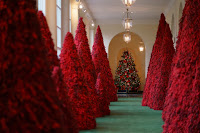 |
| Cranberry Trees at the White House |
 If you are not bound to tradition and/or symbolism and would like to change up the colors, there are many options open to an outside-of-the-box Christmas enthusiast (House Beautiful magazine has some great ideas). Nowadays, this is especially true when it comes to Christmas trees. First Lady Melania Trump took the leap and added cranberry-covered red trees to the White House decorations this year. Some people are appalled by the non-traditional look, while others applaud the creativity; I will leave it to the reader to make up his or her own mind (get a short tour of the White House decorations here).
If you are not bound to tradition and/or symbolism and would like to change up the colors, there are many options open to an outside-of-the-box Christmas enthusiast (House Beautiful magazine has some great ideas). Nowadays, this is especially true when it comes to Christmas trees. First Lady Melania Trump took the leap and added cranberry-covered red trees to the White House decorations this year. Some people are appalled by the non-traditional look, while others applaud the creativity; I will leave it to the reader to make up his or her own mind (get a short tour of the White House decorations here).
 Giant cranberry trees aside, this year’s hottest trend tree-wise is black. Yes, black! Before you dismiss the idea, imagine how cool it would look all lit up with sparkling ornaments. Or consider black and white - it makes a stunning Christmas combination. I would love to try this out, but my family would mutiny – nothing but the traditional for them. Here are some more beauteous ideas for black.
Giant cranberry trees aside, this year’s hottest trend tree-wise is black. Yes, black! Before you dismiss the idea, imagine how cool it would look all lit up with sparkling ornaments. Or consider black and white - it makes a stunning Christmas combination. I would love to try this out, but my family would mutiny – nothing but the traditional for them. Here are some more beauteous ideas for black.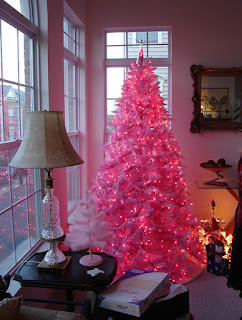

What about pink? It’s not just for little girls anymore (although perhaps a hard sell to “manly” men). These striking trees would liven up most any home.
And then there is blue. For some reason, these trees don’t seem that out-of-the-box to me. Nevertheless, I still couldn’t take one home.
If you consider blue, considering purple is the logical next step. I know a couple of people who are crazy about this color. These trees would definitely fit their décor!
 Christmas trees also come in ombre (the gradual blending of one color hue to another, with tints and shades blending from light to dark) for those who just can’t decide. Of course, there are a lot of ombre tree choices!
Christmas trees also come in ombre (the gradual blending of one color hue to another, with tints and shades blending from light to dark) for those who just can’t decide. Of course, there are a lot of ombre tree choices!Don’t get enough red, white and blue in July? Here’s one for you!
 If you like all the colors, or or if you want to make a personal statement, rainbow trees may be the choice for you.
If you like all the colors, or or if you want to make a personal statement, rainbow trees may be the choice for you.If you prefer real trees to artificial, don’t despair. Many tree farms are painting trees. Pick a tree, pick a color, cut and go! See how Wyckoff's Christmas Tree Farm in New Jersey does it here.
If you are concerned about sustainability, the only way to go is a live tree. With proper care, you will be enjoying it year-round. These pointers may help with that.
Whatever colors you choose, remember it is all about enjoying the beauty of the Christmas season.
Submitted by Pam
Subscribe to:
Comments (Atom)
Featured Post
Being Thankful at ARBICO
Here at ARBICO Organics we have a lot to be proud of – and thankful for. We are a small, family-owned company that has grown and prospered t...

-
Entomopathogenic Nematodes Ever heard of a NEMATODE? You might be more familiar with their colloquial name, which is roundworm. For the p...
-
I recently had a knee injury and was ordered to stay off it for a couple of weeks. During my forced vacation, I spent most of my time on th...
-
Our ARBICO Organics Beneficial Nematodes are one of our most popular and most effective controls for a wide-range of insect pests. These ...



